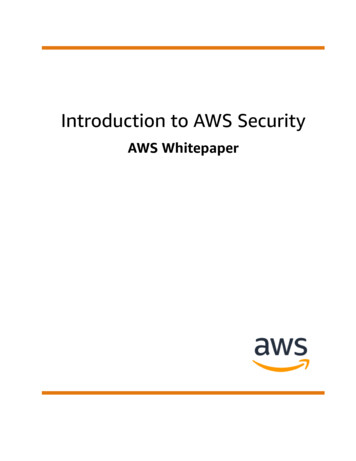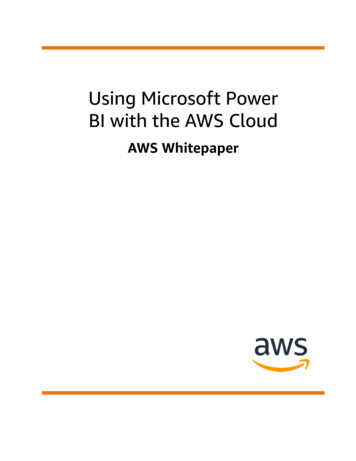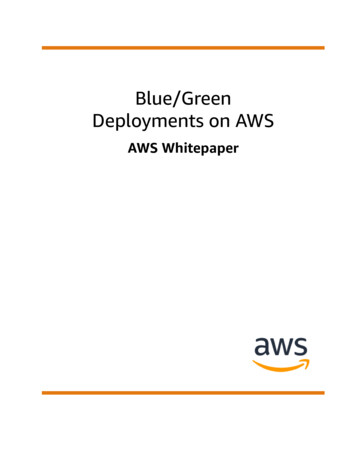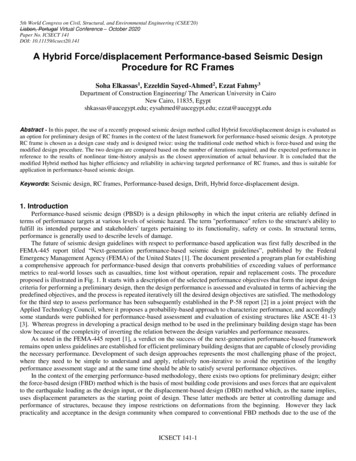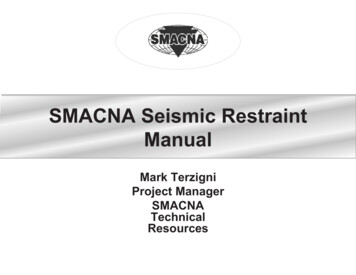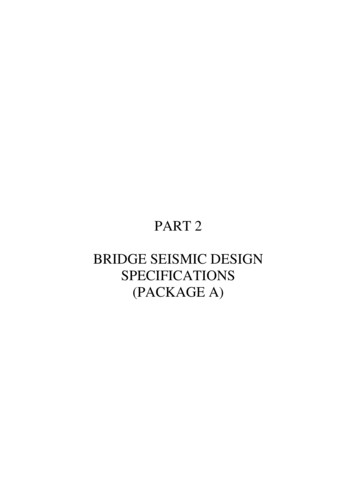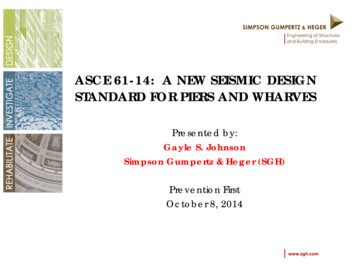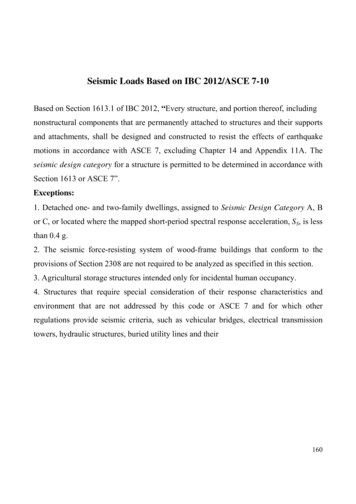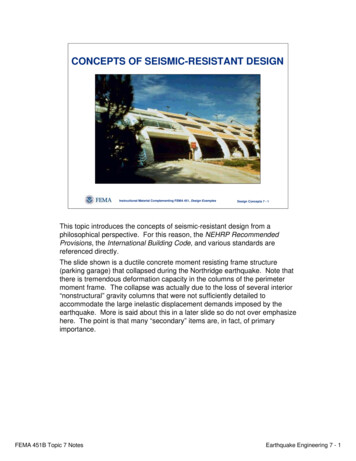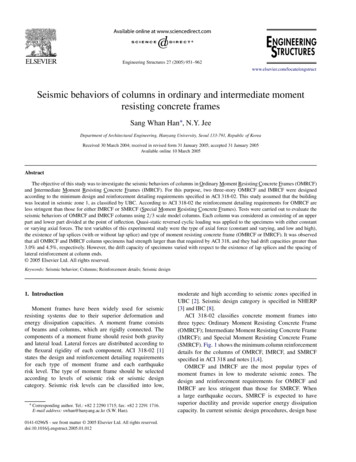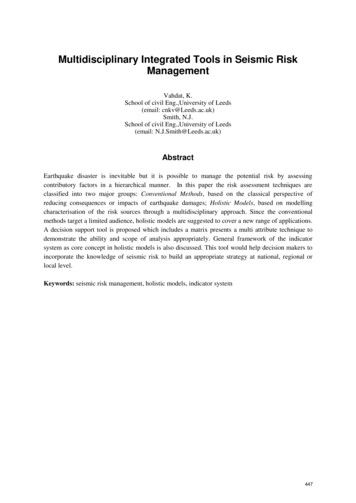
Transcription
D1.8 Seismic Supplement Welding ManualA General Overview of AWS D1.8 WeldingCode - Seismic Supplement
2D1.8 Seismic Supplement Welding ManualTable of ContentsIntroduction.2Background.4Purpose and Use.6Specifications.6Overview.8Differences from FEMA 353.10A User’s Guide To AWS D1.8.11Engineers.11Structural Detailers.12Fabricators and Erectors.12Inspectors.18References.19Lincoln Electric Products.20Exposure Testing.22Appendices.24A: D1.8 Certifications.25B: Intermix Testing.40C: Lot Control Alternative Documentation.42IntroductionLincoln Electric, the worldwide leader in weldingequipment and consumables, is proud to presentthis manual to the American Welding Society’sD1.8 Seismic Supplement.Because welding is essential in the construction ofthe vast majority of buildings, innovative weldingtechniques are and will continue to be critical tosafer, sounder structures in seismic zones.The leader in seismic welding solutions isLincoln Electric.Our leadership comes from our history; for over100 years Lincoln Electric has been at the forefrontof welding technology. It comes from our people;Duane Miller, Lincoln’s Manager of EngineeringServices, chaired the D1.8 committee. And it comesfrom our products; we have consumables andwelding solutions designed help you meet newand evolving requirements.To assist structural fabricators, erectors, inspectorsand specifying engineers, Lincoln Electric hascreated this D1.8 Seismic Supplement WeldingManual as an aid to understand seismic weldingrequirements and the Lincoln Electric consumablestested to meet the AWS D1.8 requirements.This update to Lincoln Electric’s D1.8 SeismicSupplement Welding Manual is just one more wayLincoln sets the standard for the welding industry.That is why, for the most reliable welds in seismiczones, the structural fabrication industry choosesLincoln.Note: Please refer to the Safety References Section on page 18 for more information on certificates, booklets and general safety practices.www.lincolnelectric.com
D1.8 Seismic Supplement Welding ManualCustomer Assistance PolicyThe Lincoln Electric Company sells welding consumables and related equipment. On occasion, purchasersmay ask the Company for advice or information about the use of these products. As a customeraccommodation, our employees respond without charge based on information provided and their knowledgeof Lincoln Electric products. Lincoln Electric offers no guarantee or warranty, and assumes no liability, withrespect to such information or advice; nor does it assume any responsibility for updating or correcting anysuch information or advice once it is given; nor does its provision of information or advice create, expand oralter any warranty with respect to the sale of the Company’s products. Lincoln Electric expressly disclaimsany warranty of any kind, including any warranty of fitness for any particular purpose, with respect to suchinformation or advice. The selection and use of products sold by Lincoln Electric is solely within the controlof, and remains the sole responsibility of, the customer.Document UpdatesThe information contained in this document is believed to be accurate at the time of printing and is subjectto change as additional information and data becomes available. Examples of such modifications include,but are not limited to, the incorporation of additional product data and alterations due to AWS D1.8 updates.The reader is encouraged to check the Lincoln Electric website for updates (www.lincolnelectric.com). Thismanual references other documents not published by Lincoln Electric. Those documents are also subject tochange, and the reader is encouraged to check the latest edition of referenced documents for any changesthat might affect the content of this manual.This document is an update to Lincoln Electric’s 2008 D1.8 Seismic Supplement Welding Manual andreflects changes made to the AWS D1.8 Structural Welding Code - Seismic Supplement in 2009.www.lincolnelectric.com3
4D1.8 Seismic Supplement Welding ManualBackgroundIn January 1994, the Northridge, California earthquake caused unexpected damage to a number of weldedsteel-framed buildings in the greater Los Angeles area. The Federal Emergency Management Agency (FEMA)funded a variety of investigations that sought to address both the immediate and long-term needs related tosolving the performance problems associated with welded steel moment-frame connections. Severaldocuments were published as a result of these investigations, including Recommended Specifications andQuality Assurance Guidelines for Steel Moment-Frame Construction for Seismic Applications (FEMA 353)1.FEMA 353 discusses what has come to be known as the “Pre-Northridge Connection” and concluded that“ the typical moment-resisting connection detail employed in steel moment-frame construction prior tothe 1994 Northridge earthquake had a number of features that rendered it inherently susceptible to brittlefracture. These included the following: The most severe stresses occurred in the connection “Wildcat” welding position Connection detail makes it hard to inspect Significant flexural stresses on the beam flange at the column face Weld access hole geometry High restraint Weak panel zonesThe report continued on to say “ additional conditions contributed significantly to the vulnerability ofconnections.” including: Low toughness FCAW-S welding the consumables Low redundancy Matching beam and column strengthFEMA 353 then proposed a variety of recommendations and quality assurance guidelines that addressedvarious topics, including: Overall structural design Connection design Connection details Materials, including both base metal and weld metal Workmanship Inspectionwww.lincolnelectric.com
D1.8 Seismic Supplement Welding ManualThe provisions within FEMA 353 were not binding but did become mandatory when incorporated intoContract Documents.While the FEMA recommendations were being drafted, the American Institute of Steel Construction (AISC)and the American Welding Society (AWS) began to evaluate their specifications and codes and revise them toincorporate the post-Northridge research on steel connections. AISC issued a variety of interim updates to theSeismic Provisions, as well as complete new editions of the standard. Contained in these AISC documents area variety of welding-related provisions. The primary focus of the AISC Seismic Provisions, however, is on thedesign of structures intended to resist seismically induced loads, including the design of the connections andthus, some welding-related provisions.During this same time period, the AWS D1 Structural Welding Committee formed a new subcommittee D1L,charged with the responsibility of developing a new standard to address welding-related requirements forbuildings designed to resist seismically induced loads. Ultimately, this subcommittee produced and the D1committee approved, AWS D1.8 Structural Welding Code-Seismic Supplement2.Many of the changes made to the AISC and AWS standards were the direct result of the work sponsored byFEMA. Some of the provisions directly reflect the recommendations of FEMA 353. In other cases, the initialrecommendations were modified by the AISC and AWS consensus committees. Finally, some FEMA 353recommendations deemed to be unnecessary by the AISC or AWS committees were eliminated.The FEMA-sponsored effort focused on moment-resisting connections, whereas the AISC and AWSdocuments addressed other Seismic Force Resisting Systems (SFRS), thus justifying some additionalprovisions that were not contained within FEMA 353. Therefore, these latest documents do more thansimply incorporate FEMA 353 provisions directly into AISC or AWS specifications.AWS D1.8 was approved in 2005 and first printed and distributed in 2006. In 2009 the AWS published thesecond edition of the AWS D1.8/D1.8M, Structural Welding Code - Seismic Supplement. Subsequent revisionshave also been made to this document.www.lincolnelectric.com5
6D1.8 Seismic Supplement Welding ManualThe Purpose and Use of This ManualThis manual has been prepared by The Lincoln Electric Company to assist our customers in complyingwith the requirements of AWS D1.8. Additionally, a summary of important provisions is included to assistengineers, steel detailers and inspectors. This manual does not address every provision of D1.8, and tendsto discuss only the general condition that will typically be encountered, versus unique situations that mayarise. Readers of this manual are encouraged to obtain and review a copy of AWS D1.8, which can bepurchased through the AWS (www.awspubs.com).Reference to AISC specifications is also made throughout this manual. Copies of pertinent AISC documentscan be downloaded from the AISC website (www.AISC.org) for free, or can be purchased in printed form.This manual does not in any respect act as a substitute for or in compliance with AWS D1.8 or AISCspecifications. Should any conflict exist between the content of this manual and these referencedspecifications, the documents as published by AISC or AWS should be taken as the authoritative reference.To assist the user, applicable provisions as contained in D1.8:2009 are referenced at the end of paragraphsdescribing the requirements.SpecificationsAWS D1.8 and Other SpecificationsAWS D1.8 alone cannot be used to design, fabricate, erect and inspect a structure intended toresist seismic loadings. Of necessity, D1.8 is used in conjunction with other construction documents,specifications and codes. Importantly, D1.8 does not contain all the welding-related requirements.The general interaction of D1.8 and welding-related provisions is outlined below.AWS D1.8 and AISC SpecificationsThree AISC specifications may apply to a project where seismic resistance is required: AISC 360Specifications for Structural Steel Buildings3, AISC 341 Seismic Provisions for Structural Steel Buildings4,and AISC 358 Prequalified Connections for Special and Intermediate Steel Moment Frames for SeismicApplications5. These three documents will be referred to as AISC Specifications, AISC Seismic Provisionsand AISC Prequalified Connections, respectively, throughout the remainder of this manual.The relationship between AWS D1.8 and the AISC Specifications is no different than that between the AISCSpecifications and AWS D1.1.There is significant interaction between the AISC Seismic Provisions and D1.8. Typically, AISC SeismicProvisions specify where and when certain welding related provisions apply, while AWS D1.8 will specifyhow such provisions are implemented. For example, AWS D1.8 does not specify when steel backing must beremoved from a connection. However, when backing removal is required by AISC specifications, AWS D1.8specifies how the backing is to be removed.www.lincolnelectric.com
D1.8 Seismic Supplement Welding ManualThe AISC’s Prequalified Connections document prescribes prequalified structural connections(beam-to-column connections, for example, not to be confused with AWS prequalified welding procedurespecifications, or with prequalified joint details). As part of connection prequalification, welding-relatedissues such as backing removal, weld tab removal, weld metal properties and inspection requirementsare prescribed.AWS D1.8 and Other AWS StandardsAWS D1.8 supplements AWS D1.1 Structural Welding Code—Steel6. D1.8 does not replace D1.1, and exceptas modified by D1.8, all of D1.1 still applies when D1.8 is specified. See D1.8, clause 1.1.AWS D1.8 is intended to be used on steel structures, where D1.1 applies. D1.8 should not, for example,be used to supplement AWS D1.6 Structural Welding Code—Stainless Steel7. See D1.8, clause 1.3.AWS D1.8 references the AWS A5 Filler Metal Specifications. Of particular interest is the reference to AWSA5.20: 20058 since this specification has incorporated a new supplemental electrode designator, the “-D”suffix. This suffix reflects a concept contained in both FEMA 353 and D1.8, that of high-low heat inputtesting, discussed later in this manual. It is expected that future editions of AWS A5.29 will include asimilar supplemental designator.AWS D1.8 and Contract DocumentsContract Documents are used to specify requirements that may modify provisions contained within codes.In the case of D1.8, Contract Documents play an especially important role, since many provisions typicallyrequired for buildings designed to resist seismic loading are not specified in D1.8. Rather, D1.8 requires thatwhen such provisions are to apply, the Engineer must specify them in the Contract Documents. Thus,Contract Documents may be used to “customize” requirements around a specific project. The implication isthat one project governed by D1.8 may have significantly different requirements from another, because theContract Documents for the two projects are different.AWS D1.8 and FEMA 353D1.8 and FEMA 353 are totally separate documents, and it would be impossible to impose both provisions togovern a project without creating significant conflict and contradictions. However, qualifications and varioustests done to meet the criteria of FEMA 353 may be used to meet similar or identical requirements in D1.8.Acc
AWS D1.8 and Other AWS Standards AWS D1.8 supplements AWS D1.1 Structural Welding Code—Steel 6. D1.8 does not replace D1.1, and except as modified by D1.8, all of D1.1 still applies when D1.8 is specified. See D1.8, clause 1.1. AWS D1.8 is intended to be used on steel structures, where D1.1 applies. D1.8 should not, for example, be used to supplement AWS D1.6 Structural Welding Code .
